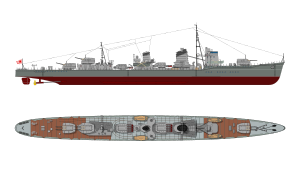Japanese destroyer Yūgumo (1941)
 Right elevation and plan of a Yūgumo-class destroyer
| |
| History | |
|---|---|
| Name | Yūgumo |
| Builder | Maizuru Naval Arsenal |
| Laid down | 12 June 1940 |
| Launched | 16 March 1941 |
| Completed | 5 December 1941 |
| Commissioned | 5 December 1941, 10th Destroyer Division |
| Stricken | 1 December 1943 |
| Fate | Sunk 6 October 1943 |
| General characteristics | |
| Class and type | Yūgumo-class destroyer |
| Displacement |
|
| Length | 119.15 m (390 ft 11 in) |
| Beam | 10.8 m (35 ft 5 in) |
| Draught | 3.75 m (12 ft 4 in) |
| Speed | 35.5 knots (40.9 mph; 65.7 km/h) |
| Complement | 225 (1941) |
| Armament |
|
Yūgumo (夕雲, "Evening Clouds") was the lead ship of her class of destroyer built for the Imperial Japanese Navy during World War II.
Design and description
The Yūgumo class was a repeat of the preceding
The main armament of the Yūgumo class consisted of six
Construction and career
Yūgumo participated in the battles of Midway, the Eastern Solomons, and the Santa Cruz Islands. The destroyer made troop transport runs to Guadalcanal on 7 and 10 November 1942. She then made troop transport runs to Buna, Papua New Guinea on 17 and 22 November. The ship then performed troop evacuation runs to Guadalcanal on 1 and 4 February 1943. Three days later, Yūgumo took part in a troop evacuation run to the Russell Islands. The destroyer made troop transport runs to Kolombangara on 1 and 5 April.
On 29 July, Yūgumo evacuated 479 soldiers from
Notes
References
- Campbell, John (1985). Naval Weapons of World War II. Annapolis, Maryland: Naval Institute Press. ISBN 0-87021-459-4.
- Jentschura, Hansgeorg; Jung, Dieter & Mickel, Peter (1977). Warships of the Imperial Japanese Navy, 1869–1945. Annapolis, Maryland: United States Naval Institute. ISBN 0-87021-893-X.
- Sturton, Ian (1980). "Japan". In Chesneau, Roger (ed.). Conway's All the World's Fighting Ships 1922–1946. Greenwich, UK: Conway Maritime Press. pp. 167–217. ISBN 0-85177-146-7.
- ISBN 1-85409-521-8.
